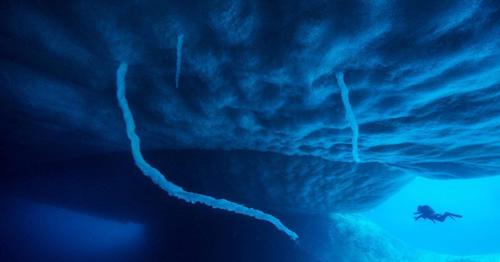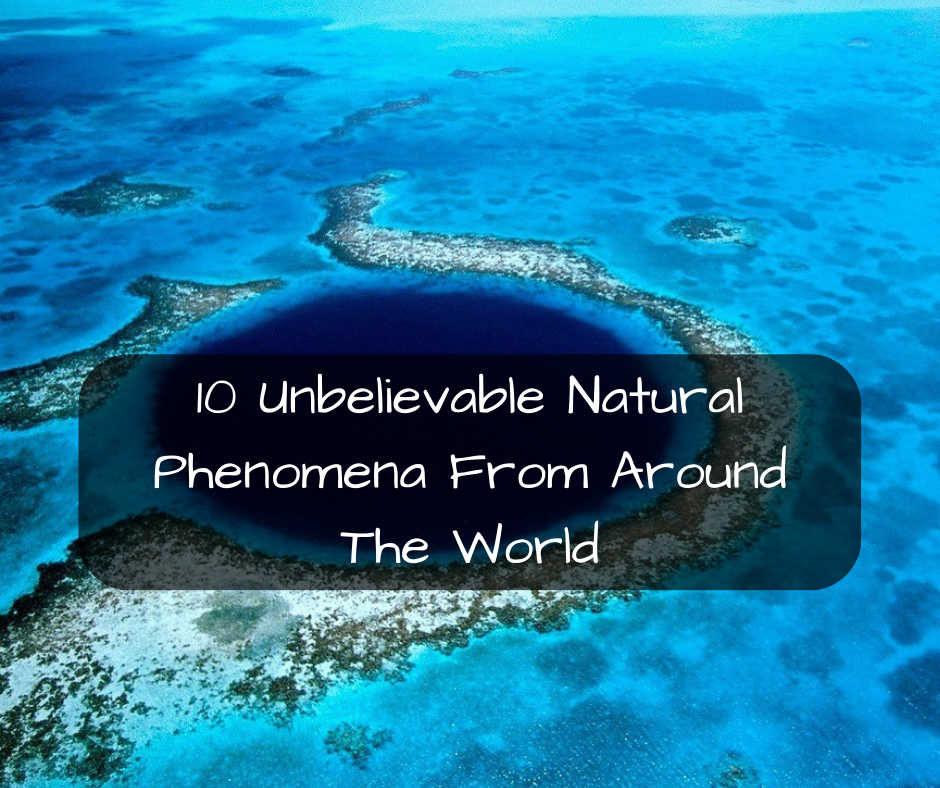The natural world is full of wonders and mysteries that continue to amaze and surprise us. From the strange and unusual movements of rocks in Death Valley to the glowing orbs of the Naga fireballs, there are countless natural phenomena that challenge our understanding of the world around us. In this blog post, we'll explore 10 of the most bizarre natural phenomena that you may have never heard of. Each of these phenomena offers a unique insight into the workings of our planet and the complexity of the natural world. So sit back, relax, and prepare to be amazed as we journey through some of the most fascinating natural phenomena from around the world.
-
Brinicles:
Brinicles, also known as "sea stalactites," are one of the most bizarre natural phenomena on the planet. These icicle-like formations are formed beneath the ocean's surface when cold, dense saltwater sinks to the bottom and freezes everything it touches. The resulting structure resembles a stalactite, but instead of forming on the ceiling of a cave, it forms on the ocean floor. [Click image to Zoom]

Brinicles Brinicles are formed when seawater freezes at the ocean's surface, creating a layer of ice that floats on top of the denser saltwater below. As the cold, salty water sinks to the ocean floor, it comes into contact with warmer water and begins to melt, creating a small tube of liquid water around the descending column of cold water. This tube of water continues to grow as more cold water flows down, eventually forming a brinicle.
Brinicles are relatively rare, as the conditions required for their formation are very specific. They are typically found in the polar regions, where the surface water is cold enough to freeze and the deeper water is dense enough to sink to the ocean floor. Scientists are still studying these strange formations to learn more about their formation and potential impact on marine life.
-
Penitentes:
Penitentes are tall, narrow, spiky ice formations that can be found at high altitudes in the Andes Mountains. These formations are named after the penitents, or religious pilgrims, who would wear tall, pointed hoods to signify their penance. [Click image to Zoom]

Penitentes Penitentes are formed by the sun evaporating snow and ice, leaving behind tall blades of ice that can reach up to several meters in height. The sharp peaks and ridges of the formations are oriented perpendicular to the sun's rays, which causes them to cast long shadows and helps to protect the ice from melting.
The formation of penitentes is a complex process that involves the interaction of several factors, including temperature, humidity, and wind direction. They are typically found in high-altitude regions where the air is dry and the temperature remains below freezing for much of the year.
Penitentes are not only fascinating to look at, but they also play an important role in the local ecosystem. The high ridges and peaks of the formations provide shelter for small animals and plants, and the meltwater from the ice can help to nourish the surrounding vegetation.
-
Catatumbo Lightning:
Catatumbo Lightning is a unique form of lightning that occurs over Lake Maracaibo in Venezuela. This phenomenon is characterized by its frequency, intensity, and duration, with lightning strikes occurring up to 140 times per hour and lasting for up to 10 hours at a time. [Click image to Zoom]

Catatumbo Lightning The cause of Catatumbo Lightning is still not fully understood, but it is believed to be related to the interaction of warm, moist air from the Caribbean with the cold, dry air from the Andes Mountains. The resulting thunderstorms can produce intense lightning displays that are visible for miles around.
Catatumbo Lightning has been observed for centuries and is often cited as one of the most impressive natural wonders in the world. The lightning is so intense that it has been used by sailors as a navigational aid, and it is also an important part of the local culture, with festivals and celebrations held in honor of the phenomenon.
-
Fire Whirls:
Fire whirls, also known as fire tornadoes, are spinning vortexes of flames that can occur during wildfires, tornadoes, or volcanic eruptions. These phenomena are caused by the combination of strong winds, intense heat, and the presence of combustible materials. [Click image to Zoom]

Fire Whirls Fire whirls can range in size from small whirlwinds to massive tornado-like formations that can reach heights of several hundred meters. They are incredibly dangerous and can spread fires over long distances, making them a significant threat to both people and wildlife.
The formation of fire whirls is a complex process that involves several factors, including wind speed, temperature, and humidity. As the hot air rises from the fire, it begins to spin due to the Coriolis effect, which causes the air to rotate around a central axis. As the spinning column of air moves across the landscape, it can pick up debris and flames, creating a fire whirl.
While fire whirls are a relatively rare phenomenon, they can be incredibly destructive. They can create their own weather patterns and generate winds that can spread fires in unpredictable directions. Firefighters must be aware of the potential for fire whirls and take appropriate precautions to ensure their safety.
-
Hessdalen Lights:
The Hessdalen Lights are a series of unexplained lights that have been observed in the sky over Hessdalen Valley in Norway. These lights appear as bright, glowing orbs that move erratically through the sky, sometimes disappearing and reappearing in a different location. [Click image to Zoom]

Hessdalen Lights The cause of the Hessdalen Lights is still unknown, although several theories have been proposed. Some scientists believe that the lights may be caused by a natural phenomenon, such as electrical discharges from the Earth's crust or the ionization of air particles. Others suggest that the lights may be related to extraterrestrial activity or even a secret military experiment.
Despite decades of research, the Hessdalen Lights remain a mystery. They continue to fascinate scientists and UFO enthusiasts alike, with numerous expeditions and investigations being carried out to try to unravel the secrets of this strange phenomenon.
-
Blood Falls:
Blood Falls is a natural phenomenon that occurs in Antarctica's McMurdo Dry Valleys. This bizarre phenomenon is named for its eerie red color, which is caused by the presence of iron oxide in the water. [Click image to Zoom]

Blood Falls The source of the water in Blood Falls is a subglacial lake that has been sealed off from the rest of the world for millions of years. The water contains a high concentration of salt, which keeps it from freezing even in the extreme cold of Antarctica. As the water flows out of the glacier and into the air, it reacts with oxygen, causing it to turn red.
Blood Falls is not only a fascinating natural phenomenon, but it also provides valuable information about the history of the Earth. The water in the falls is believed to have been isolated for millions of years, making it a potential source of information about the planet's ancient climate and geological history.
-
Sailing Stones:
Sailing stones, also known as sliding rocks, are a bizarre natural phenomenon that occurs in Death Valley National Park in California. These rocks, some of which weigh up to several hundred pounds, appear to move across the desert floor on their own, leaving long tracks behind them. [Click image to Zoom]

Sailing Stones The cause of the movement of sailing stones is still not fully understood, but it is believed to be related to the presence of ice. When the desert floor is wet, a thin layer of ice can form on the surface. As the sun rises and the ice begins to melt, it creates a lubricating layer that allows the rocks to move across the surface of the desert.
While the movement of the sailing stones is a fascinating natural phenomenon, it is also a significant threat to the fragile desert ecosystem. In recent years, visitors to Death Valley National Park have been prohibited from touching or moving the stones in an effort to protect the delicate environment.
-
Underwater Crop Circles:
Underwater crop circles are a bizarre phenomenon that occurs in the shallow waters off the coast of Japan. These intricate circular patterns, which can measure up to 2 meters in diameter, are created by a species of pufferfish that uses them to attract mates. [Click image to Zoom]

Underwater Crop Circles Male pufferfish create these intricate patterns by swimming along the seafloor and flapping their fins. They use their mouths to collect and arrange small rocks, shells, and other debris into circular patterns that are used to attract female pufferfish.
The purpose of the circles is to provide a safe and secure environment for the eggs of the female pufferfish. The circular patterns help to create a current that circulates water around the eggs, providing them with oxygen and helping to prevent them from becoming infected with bacteria.
While underwater crop circles may seem like a minor curiosity, they provide valuable insights into the behavior and social structures of marine life. Scientists are still working to understand the complex interactions between pufferfish and other marine species and how they contribute to the health and sustainability of our oceans.
-
Blue Holes:
Blue holes are underwater sinkholes that can be found in oceans and freshwater lakes around the world. These deep, circular holes can reach depths of over 300 meters and are home to a variety of marine life, including sharks, rays, and sea turtles. [Click image to Zoom]

Blue Holes The name "blue hole" comes from the deep blue color of the water, which is caused by the absence of sunlight at such great depths. The lack of sunlight also means that the water in blue holes is very cold and contains very little oxygen, making it a challenging environment for marine life.
Despite the difficult conditions, blue holes are important ecosystems that provide valuable insights into the biodiversity and evolution of marine life. They also provide valuable resources for scientists and researchers who study the geological and environmental history of our planet.
-
Naga Fireballs:
Naga fireballs are a natural phenomenon that occurs in the Mekong River in Thailand and Laos. These bright, glowing orbs rise out of the water and float through the air before disappearing. [Click image to Zoom]

Naga Fireballs The cause of the Naga fireballs is still unknown, although several theories have been proposed. Some scientists believe that the orbs are caused by a natural phenomenon, such as methane gas bubbles rising to the surface. Others suggest that the fireballs may be related to supernatural or spiritual forces.
Despite decades of research, the Naga fireballs remain a mystery, and they continue to attract tourists and researchers from around the world. The phenomenon has become an important part of the cultural heritage of the region, and it is celebrated every year with a festival that attracts thousands of visitors.
Conclusion:
Natural phenomena have fascinated humans for centuries, and as we continue to explore and study our planet, we discover new and exciting phenomena that challenge our understanding of the world around us. From the bizarre movements of sailing stones in Death Valley to the glowing orbs of the Hessdalen Lights, each of these phenomena offers valuable insights into the workings of our planet and the complexity of the natural world. By continuing to study and explore these phenomena, we can deepen our understanding of the world and gain a greater appreciation for the beauty and wonder of nature.
Discover More
Most Viewed
Christmas is a season of joy, love, and traditions. And what better way to get into the holiday spirit than through timeless carols? These musical gems have been bringing people together for generations. Here’s our ranked list of the Top 10 Christmas Caro…
Read More

















